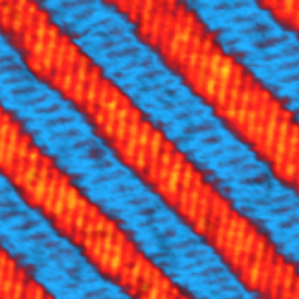Materials Trick Might Help Move Computers Beyond Silicon
After decades of repeated reinvention, the silicon transistor is starting to show its age, and the industry is hunting for alternatives. One option involves a new way of manipulating the properties of a material that the computer industry already uses. If it works, it would lead to computer processors that are not only more energy-efficient but also capable of both computation and memory storage at once.

With some tinkering, researchers found that they could make ferroelectric materials—widely used to store data using an electrical charge—switch rapidly between four different states. A transistor made of the material could use those states to represent more than the 1s and 0s that are the basis of today’s digital logic; it could hold each state without the need for an external power source; and it might be able to process information as well as store it.
As silicon transistors are shrunk down to the nanoscale, they are reaching the limits of performance, resulting in problems with power consumption, heat dissipation, and speed. Devices that work in fundamentally different ways may be needed to overcome these challenges, says Thomas N. Theis, a scientist at IBM’s Watson Research Center in Yorktown Heights, New York, and executive director of the Nanoelectronics Research Initiative at the Semiconductor Research Corporation, an industry consortium.
One major advantage of ferroelectric materials is that they aren’t new to the semiconductor industry, says Lane Martin, a materials scientist at the University of California, Berkeley, who led the new research. Fujitsu, Texas Instruments, and others already make ferroelectric memory devices. “We’re working on a new version of these materials, so if companies want to adapt it, there won’t be a 10-year scale-up process” like there typically is for new materials, says Martin.
Martin is collaborating with theoretical chemist Andrew Rappe at the University of Pennsylvania to model and test ferroelectrics.
Like silicon transistors, ferroelectric cells can be made to switch between different states to represent bits of information. But the physics of switching are fundamentally different. Instead of switching between conducting and insulating states, ferroelectric materials switch electrical polarization—the orientation of charges within the material.
Ferroelectric materials have a natural electrical polarization, and it’s possible to flip charges to the opposite direction using an electric field. So far this switching, which takes a few nanoseconds, is fast enough for data storage, but too slow for data processing; and it takes considerable energy.
Rappe predicted that by growing ferroelectric crystals at a particular angle, and applying the electric field from a different angle than is usually used, the materials would switch differently. Beyond up and down, there are also intermediate states that Martin calls “side states.”
Martin made cells from various ferroelectric materials, including lead zirconate titanate, and showed that they can be switched much faster, and at lower voltages, when the state transition goes from up to side to down, than from up to down directly. The results are published today in the journal Nature Materials. Martin says these ferroelectric switches also work at least two to three times faster than the conventional designs.
The work seems to represent a “very substantial advance” in the understanding of these materials, says IBM’s Theis.
Martin says he and Rappe want to go beyond using ferroelectrics for memory. One idea is to combine these ferroelectrics with silicon to make fundamentally new kinds of transistors. Such a device would be energy-efficient, and would combine computing and memory all in one, says Martin. “You could then come right back to what you were doing if the power goes off—which is convenient for home use and would save money for data centers,” says Martin.
Keep Reading
Most Popular
Large language models can do jaw-dropping things. But nobody knows exactly why.
And that's a problem. Figuring it out is one of the biggest scientific puzzles of our time and a crucial step towards controlling more powerful future models.
How scientists traced a mysterious covid case back to six toilets
When wastewater surveillance turns into a hunt for a single infected individual, the ethics get tricky.
The problem with plug-in hybrids? Their drivers.
Plug-in hybrids are often sold as a transition to EVs, but new data from Europe shows we’re still underestimating the emissions they produce.
Stay connected
Get the latest updates from
MIT Technology Review
Discover special offers, top stories, upcoming events, and more.